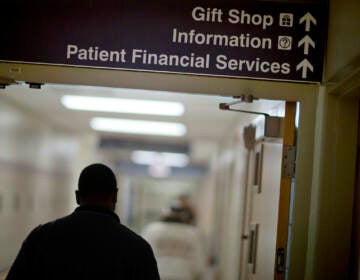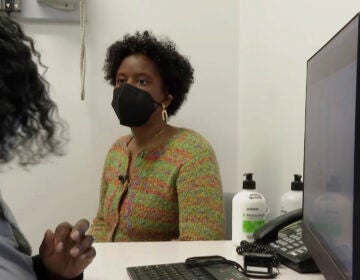To curb spread of HIV, Episcopal Hospital starts people on PReP in emergency room
The recent spike in HIV among people in Philadelphia who use injection drugs has prompted new steps to stop the virus’ spread.

PReP provides a 92 percent chance of preventing HIV. (Britta Pedersen/Associated Press)
A few months ago, doctors at Temple Health’s Episcopal Hospital in Kensington started hearing a new request from patients coming into their emergency department: They were asking for pre-exposure prophylaxis, or PReP.
PReP is a prescription pill that, if taken daily, has a 92 percent chance of preventing HIV from being contracted. It’s usually taken by people who believe they are at risk for getting the virus. PrEP is often recommended for men who have sex with men, and for people whose sexual partners are HIV-positive. It also can be a good fit for sex workers and injection drug users.
Between 2016 and 2018, the number of people with HIV who inject drugs in Philadelphia has more than doubled, to 59, according to city figures. Experts and doctors are calling the increase a micro-epidemic. To counter the surge, various agencies around the city are ramping up education efforts around PReP. The Philadelphia Department of Public Health is working with doctors in areas with high rates of HIV to train them how to talk to patients about PReP. The nonprofit syringe exchange Prevention Point is working with people who use drugs, to let them know that PrEP is an available option.
But once you know about PReP, how do you get it?
For some in Kensington, the emergency room is the easiest and most convenient option.
“We had people coming into the ER asking for prophylaxis knowing they were engaging in high-risk behavior,” remembered Kraftin Schreyer, medical director at the Episcopal ER. “And we were honestly not very well prepared to handle their request.”
Schreyer said some people would ask about PReP because they came in for something else — maybe an abscess related to injection-drug use. Some, though, just came in because they had heard about it and wanted to know more.
Until recently, Temple’s emergency departments didn’t even test for HIV, which is recommended by the Centers for Disease Control and Prevention. In part, that’s because adding any sort of primary-care services to the slate of ER doctors’ responsibilities is unpopular. For one thing, physicians in the emergency room are busy, with a high volume of patients to attend to. They also don’t generally want to do bloodwork if they don’t have to, and at Temple the test for HIV is a fourth-generation antigen test that involves drawing blood and usually requires 24 hours to yield results.
That brings about the next obstacle: ER doctors are generally reluctant to run any sort of test that would require them to follow up with patients after they have left the emergency department.
“We didn’t want to take on the burden of following up on tests if we’re not going to ensure that we can see the patients on a repeat visit,” said Schreyer.
PrEP requires a lot of ongoing care, too. Many practitioners liken it to birth control: A patient can go on it or off it at different times, depending on what makes sense for her and what’s going on in her life. ER doctors are not in the position to be taking on continual care like that.
Taking all that into account, Schreyer teamed up with Gina Simoncini at Temple’s HIV outpatient clinic to find a solution. Here’s how it works:
If a person is interested in PReP while in the emergency department at Temple University Hospital or Episcopal Hospital in Kensington, a provider will offer a panel of tests that screens for HIV and STDs. They’ll have a conversation about how to take PReP and the side effects, which are rare. If it seems like a good fit, the patient will walk out the door with a first day’s dose and a one-month prescription for PReP.
The doctor will note that information on the patient’s electronic medical record, and Simoncini and her team will get a little ping, notifying them they have a new patient. They’ll get in touch with the patient to go over the test results and establish follow-up care. If it turns out a patient is HIV-positive, they’ll work with the patient to switch over to HIV treatment as soon as possible.
The system went into effect last week.
Others in the HIV prevention field agreed that if you can get past the logistical obstacles, the ER offers a great opportunity to start people on PrEP.
“I think you capture a population that may not be accessing medical care elsewhere that may be using emergency rooms as their primary-care providers” said Erika Aaron, the PrEP clinical adviser for Philadelphia’s Aids Activities Coordinating Office.
Research shows that starting someone on birth control or HIV medication right away, instead of writing a referral to see another doctor, increases the chances the patient will stick with the treatment. Aaron said she expects the same would follow for PrEP.
The city’s Federally Qualified Health Centers and many primary-care providers offer PrEP. But Simoncini said the drug suffers from what she described as a “purview paradox,” where no single field has stepped up to own it.
“Is it primary care, STD clinics, OB/GYN, or family planning? Who’s doing this? That can be quite confusing for patients,” Simoncini said.
Aaron noted that although they aren’t treating HIV when they offer PrEP, primary-care doctors often feel like it’s out of their wheelhouse.
“It’s one of the easiest things that they’re probably prescribing, given all the other chronic illnesses that a patient is probably dealing with,” Aaron said of primary-care doctors. “But I think there’s a fear because they’re not comfortable treating HIV, and they feel like a specialist should be doing it.”
Aaron is training doctors how to talk to patients about PrEP and become more comfortable prescribing it. She is also reaching out to providers of medication-assisted treatment to talk to people who are entering recovery about PrEP.
Schreyer said the cost to the ER is minimal — it’s simply the lab tests and the initial dose of PrEP. She said she imagines her department will see an increase in people asking for PrEP as word spreads.
WHYY is your source for fact-based, in-depth journalism and information. As a nonprofit organization, we rely on financial support from readers like you. Please give today.





